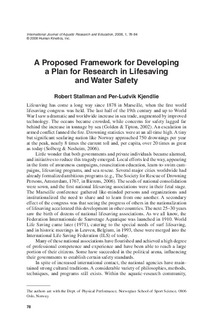| dc.contributor.author | Stallman, Robert Keig | |
| dc.contributor.author | Kjendlie, Per-Ludvik | |
| dc.date.accessioned | 2009-05-12T11:31:07Z | |
| dc.date.issued | 2008-02 | |
| dc.identifier | Seksjon for fysisk prestasjonsevne / Department of Physical Performance | |
| dc.identifier.citation | International Journal of Aquatic Research and Education. 2008, 2(1), 78-84 | en |
| dc.identifier.issn | 1932-9997 | |
| dc.identifier.uri | http://hdl.handle.net/11250/170463 | |
| dc.description.abstract | In the centers for aquatic
research, the infrastructure, methodology, and expertise already exist. What remains
is to integrate the needs and interests of lifesaving research into these programs.
Especially in physiology and biomechanics, the tools are already in place. The ILS,
with two world congresses under its belt, is the ideal agency to foster systematic
lifesaving research. This article addresses that issue and recommends a framework
for developing a plan for research in lifesaving and water safety. | en |
| dc.format.extent | 78547 bytes | |
| dc.format.mimetype | application/pdf | |
| dc.language.iso | eng | en |
| dc.publisher | Human Kinetics | en |
| dc.subject | aquatic sports - safety measures | |
| dc.subject | drowning - prevention | |
| dc.subject | planning | |
| dc.subject | research | |
| dc.subject | lifesaving | |
| dc.subject | rescue work | |
| dc.title | A proposed framework for developing a plan for research in lifesaving and water safety | en |
| dc.type | Peer reviewed | en |
| dc.type | Journal article | en |
| dc.subject.nsi | VDP::Social science: 200::Social science in sports: 330 | en |
| dc.source.pagenumber | 78-84 | en |
| dc.source.volume | 2 | en |
| dc.source.journal | International Journal of Aquatic Research and Education | en |
| dc.source.issue | 1 | en |
